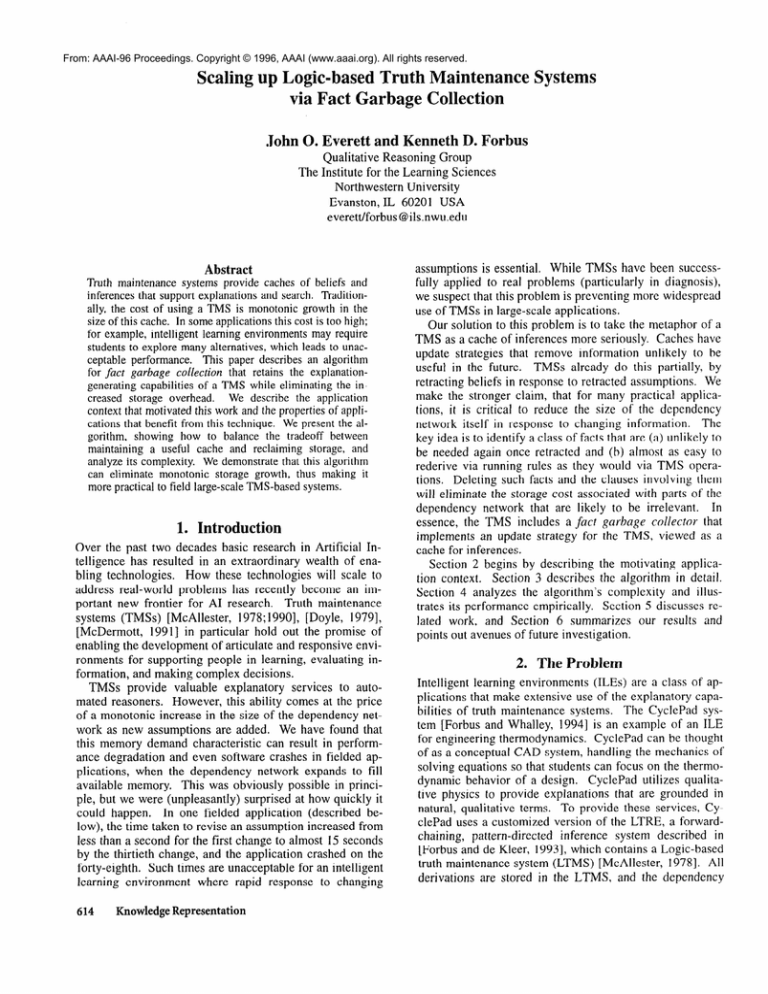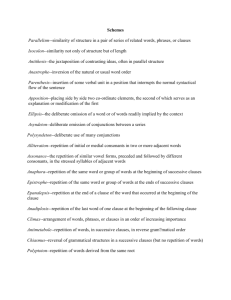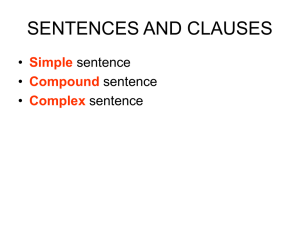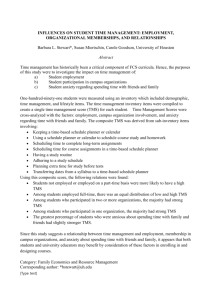
From: AAAI-96 Proceedings. Copyright © 1996, AAAI (www.aaai.org). All rights reserved.
Scaling up Logic-based Truth Maintenance Systems
via Fact Garbage Collection
John 0. Everett and Kenneth D. Forbus
QuaIitative Reasoning Group
The Institute for the Learning Sciences
Northwestern University
Evanston, IL 60201 USA
everett/forbus@ils.nwu.edu
Abstract
Truth maintenance systems provide caches of beliefs and
inferences that support explanations and search. Traditionally, the cost of using a TMS is monotonic growth in the
size of this cache. In some applications this cost is too high;
for example, intelligent learning environments may require
students to explore many alternatives, which leads to unacThis paper describes an algorithm
ceptable performance.
for fact garbage collection that retains the explanationgenerating capabilities of a TMS while eliminating the inWe describe the application
creased storage overhead.
context that motivated this work and the properties of appfications that benefit from this technique. We present the algorithm, showing how to balance the tradeoff between
maintaining a useful cache and reclaiming storage, and
analyze its complexity. We demonstrate that this algorithm
can eliminate monotonic storage growth, thus making it
more practical to field large-scale TMS-based systems.
I.
Introduction
Over the past two decades basic research in Artificial Intelligence has resulted in an extraordinary wealth of enaHow these technologies will scale to
bling technologies.
address real-world problems has recently become an important new frontier for AI research.
Truth maintenance
systems (TMSs) [McAllester, 1978; 19901, [Doyle, 19791,
[McDermott, 19911 in particular hold out the promise of
enabling the development of articulate and responsive environments for supporting people in learning, evaluating information, and making complex decisions.
TMSs provide valuable explanatory services to automated reasoners.
However, this ability comes at the price
of a monotonic increase in the size of the dependency network as new assumptions are added. We have found that
this memory demand characteristic can result in performance degradation and even software crashes in fielded applications, when the dependency network expands to fill
available memory. This was obviously possible in principle, but we were (unpleasantly) surprised at how quickly it
In one fielded application (described becould happen.
low), the time taken to revise an assumption increased from
less than a second for the first change to almost 15 seconds
by the thirtieth change, and the application crashed on the
forty-eighth. Such times are unacceptable for an intelligent
learning environment
where rapid response to changing
614
Knowledge
Representation
assumptions is essential. While TMSs have been successfully applied to real problems (particularly in diagnosis),
we suspect that this problem is preventing more widespread
use of TMSs in large-scale applications.
Our solution to this problem is to take the metaphor of a
TMS as a cache of inferences more seriously. Caches have
update strategies that remove information unlikely to be
useful in the future. TMSs already do this partially, by
retracting beliefs in response to retracted assumptions.
We
make the stronger claim, that for many practical applications, it is critical to reduce the size of the dependency
network itself in response to changing information.
The
key idea is to identify a class of facts that are (a) unlikely to
be needed again once retracted and (b) almost as easy to
rederive via running rules as they would via TMS operations. Deleting such facts and the clauses involving them
will eliminate the storage cost associated with parts of the
dependency network that are likely to be irrelevant.
In
essence, the TMS includes a fact garbage collector that
implements an update strategy for the TMS, viewed as a
cache for inferences.
Section 2 begins by describing the motivating application context. Section 3 describes the algorithm in detail.
Section 4 analyzes the algorithm’s complexity and illustrates its performance empirically.
Section 5 discusses related work, and Section 6 summarizes our results and
points out avenues of future investigation.
2.
The Problem
Intelligent learning environments (ILEs) are a class of applications that make extensive use of the explanatory capabilities of truth maintenance systems. The CyclePad system [Forbus and Whalley, 19941 is an example of an ILE
for engineering thermodynamics.
CyclePad can be thought
of as a conceptual CAD system, handling the mechanics of
solving equations so that students can focus on the thermodynamic behavior of a design. CyclePad utilizes qualitative physics to provide explanations that are grounded in
natural, qualitative terms. To provide these services, CyclePad uses a customized version of the LTRE, a forwardchaining, pattern-directed
inference system described in
[Forbus and de Kleer, 19931, which contains a Logic-based
truth maintenance system (LTMS) [McAllester, 19781. All
derivations are stored in the LTMS, and the dependency
network so formed provides the grist for a generative hypertext explanation system that lets students explore the
consequences of their assumptions.
CyclePad is designed to shift the focus of the student
from solving equations to developing
better intuitions
This requires that students explore
about thermodynamics.
the consequences of parametric changes to cycles they have
designed, often via sensitivity analyses. As a consequence,
the underlying LTRE may be called upon to make dozens
or even hundreds of changes to assumptions involving numerical values during a typical student session. Each of
these changes can have extensive consequences; the analysis of a complex cycle might require between 10 and 30
assumptions, which result in the derivation of hundreds of
additional numerical values.
The large number of assume/retract cycles and the potentially large number of consequences
affected by each
cycle means that the cost of this operation dominates CyclePad’s performance.
Observations of CyclePad in typical
conditions suggest that the amount of memory consumed
rises linearly with the number of assume/retract
cycles,
while the time taken for each cycle rises non-linearly.
There are two sources for the non-linear time increase: (1)
there are more clauses to process on each iteration, because
the dependency
network has grown, and (2) as storage
space begins to run out, the Lisp garbage collector and the
virtual memory system require a much larger fraction of the
total time.
3. Fact Garbage Collection
Our solution to this problem is to designate certain classes
of facts as eligible for deletion when they become unknown. We preserve the integrity of the dependency network for producing explanations of current beliefs at the
cost of greater reliance on the inference engine to rederive
facts. This solution makes sense when one can identify
classes of facts in which (1) it is unlikely that a particular
fact will be believed again once it is retracted and (2) the
cost of rederivation is small. Numerical assumptions in
CyclePad fit both of these criteria. Using a fact garbage
collector and designating statements of numerical values as
collectible results in a significant improvement
in CyclePad’s performance.
Empirically, we have assumed and
retracted 1000 consecutive values at an average time per
assumption/retraction
cycle of 3.1 seconds.
In contrast,
CyclePad with the conventional LTRE on the same example exhausted a 32MB memory space at 48 changes, at
which point the average retraction was requiring 46 seconds.
The rest of this section describes the fact garbage collection algorithm, and a particular implementation
of it,
GC-LTRE. We begin with a brief overview of some relevant LTMS and LTRE concepts, and then describe the fact
garbage collection algorithm in detail.
3.1 Overview of LTMWLTRE
Like all TMSs, the LTMS consists of nodes and clauses,
where nodes correspond to facts and clauses enforce belief
The LTMS encodes
relationships
among those facts.
clauses in disjunctive normal form. Although this encoding
enables clauses to operate in all directions (i.e., not just
from antecedent to consequent), any particular use of them
in a derivation does identify a set of antecedents and a particular conclusion.
Relationships
between beliefs are
maintained via Boolean constraint propagation (BCP).
The LTRE is a forward-chaining,
pattern-directed
rule
system that uses the LTMS to maintain a database of facts
related to one another via logical dependencies.
Facts are
assigned truth values, which may be true, false, or unknown, according to the label of the corresponding LTMS
node. LTRE rules consist of a list of triggers and a body.
Each trigger consists of a truth condition and a pattern.
The body of a rule is executed for each combination
of
facts which both match the trigger patterns and whose truth
values simultaneously
satisfy the truth conditions of the
triggers.’ Once their trigger conditions are satisfied, rules
are exhaustively executed in an arbitrary order. The LTMS
caches partially executed rules on the node of the trigger
fact that failed to match its truth condition, and signals the
inference engine to re-queue these rules when that node’s
label changes appropriately.
Rule bodies interact with the LTMS by asserting new
facts and logical relations, which in turn cause the LTMS to
add corresponding
nodes and clauses to its database.
Changes in a fact’s label are thus automatically updated by
the LTMS, rather than requiring repeated execution of
rules. Because of this, the conventional LTRE guarantees
that a rule will run exactly once on each set of facts to
which it has matched, to avoid the wasted work and duplication of clauses that would result. One subtlety in making
a fact garbage collector is ensuring that rules are reexecuted in certain circumstances described below.
3.2
The FACT-GC Algorithm
To garbage-collect
facts we must (a) be able to identify
collectible facts, (b) ensure that all relevant structure is
removed, and (c) cache information for restoring clause
structure under certain circumstances
(discussed below).
We address the identification
of collectible facts by requiring applications to provide a predicate GCable?
that
is true exactly when a fact is of a type that should be collected when it becomes unknown. (We discuss how to define GCable?
in Section 3.4.) Ensuring the deletion of
all relevant structure and the caching of clause information
only requires modifications of the LTMS operations carried out when retracting an assumption.
Here is the new
LTMS retraction algorithm:
’ The simultaneity requirement is a modification to the LTRE
presented in [Forbus & de Kleer, 19931. As it results in a substantial performance improvement, all versions of the LTRE used
in experiments described in this paper have this modification.
Knowledge Bases & Context
615
Retract-Assumption(n)
1. Label(n) = UNKNOWN
2. Queue = Propagate-Unknownness(n)
3. Find-Alternate-Support(queue)
4. Fact-GC(queue)
The first three steps of retract-assumption
are
identical
to those of the LTRE described in [Forbus & de
Kleer, 19931, with the exception of retaining the queue
computed in propagate-unknownness
for additional
processing. Fact garbage collection is only attempted after
seeking alternate support so that still-labeled TMS structure is not removed.
The fact -gc algorithm simply finds collectible nodes
among those that were retracted and executes co1 let t node on them:
Fact-GC(queue)
1. For each node n in queue,
lf label(n) = UNKNOWN and GCable?(n)
then Collect-Node(n)
Collect-Node(n)
1. For each clause c that n participates in,
A. Create-Restoring-Thunk(C)
B. Delete(C)
2. For each rule instance R which includes n in its
bound triggers, Delete (R)
3. Delete(n)
Step 1 of collect-node,
the cachingof clauseinformation,
issomewhat subtle,
so we describe
itlast.Step 2 ensures that every unexecuted rule instantiation formed in part
by triggering
on n is destroyed,
both to avoid reintroducing collected nodes and to save the effort of executing moot rules. Step 3 deletes the node itself.
Steps 2 and 3 require processing at both the TMS and inference engine levels. In Step 2, partially-bound rules must
be removed from the inference engine and from the TMS’s
cache of partially-executed
rules. This step has the desirable side-effect of a substantial reduction in memory usage,
as the number of rules in a conventional CyclePad LTRE
can be 2,000 at startup, and rises monotonically
to five
times that amount during a typical user session. In Step 3,
the node and its corresponding
inference engine fact are
deleted from the TMS and inference engine respectively.
Step 1 caches information
necessary to recreate the
clause about to be deleted. This is necessary because the
traditional contract ‘between inference engine and TMS
requires that rules are only run once. Since clauses are the
product of rules, the deletion of a clause can cause permanent loss of information from the LTRE unless we take
steps to ensure that its creating rule runs again.
An example will clarify this point. Suppose we have the
simple database formed by the sequence of transactions:
Assume
A*l3
(A)
where both A and B are collectible, and A j B is installed by a rule that was triggered by A becoming true.
Retracting A will cause B to be retracted, and both will be
616
Knowledge Representation
collected, along with the clause that linked them. This is
both desirable and safe; if A is assumed again in the future,
the same rule will execute to create another clause, and the
system will again believe B as a result. But suppose that A
were not collectible.
Retracting A would cause B to be
retracted.
If we collected B, we would delete the clause
linking A and B. But since A is still in the database, the
rule which triggered on A will not be re-executed, and a
valid inference is permanently lost.
The subtlety inherent in this step arises from the expressiveness of LTRE rules. Consider the set of literals which
participate in the clauses that the execution of a particular
Generally some subset of these literals
rule generates.
(e.g., the antecedents of an implication) will appear in the
rule’s triggers. Call these trigger literals. Our GC algorithm generally requires all non-collectible
literals of a rule
to be trigger literals, in order to ensure the proper caching
of a clause-restoring thunk.
A restoring thunk is needed exactly when a clause is being deleted because its consequent is being gc’d and when
at least one of its antecedents is both unknown and not gcable:
Create-Restoring-Thunk(C)
1. Retrieve rule instance R used to create c
2. Find antecedent M in c such that TGCable? (M)
and Unknown(M)
3. If antecedent M found then schedule R to be executed when M receives the appropriate label.
The LTMS caches the environment of the rule instance in
force with each clause when it is constructed.
Createrestoringthunk
moves this information
from the
about-to-be-deleted
clause to a cache associated with a
non-gc-able and unknown antecedent.
In the above example this antecedent would be the node corresponding to A.
Should A become believed at some future time, the TMS
will check this cache and signal the inference engine to
schedule any rules found there for execution, thus ensuring
that the clause implying B will be re-instantiated.
This is
merely an extension of the services that the TMS already
provides in keeping track of partially executed rules.
For this algorithm to work correctly, any non-collectible
literal which becomes unknown must be a trigger literal.
Otherwise, there is no appropriate place to cache the thunk,
and step 3 above will not execute. The exception to this is
when a rule involves no collectible literals, for this reduces
to the standard LTMS case.
There are also two cases in which it is possible that step
3 will not execute yet the LTRE will not permanently lose
structure: (a) when the application bypasses the rule engine
and installs clauses directly, and (b) when all trigger literals
are either unknown and gc-able or known. In the first case,
the onus for restoring the clause rests with the application.
The only responsibility
of the TMS in this instance is to
signal the application that a directly-installed
clause is to be
deleted and return that clause to the application.
In the
second case the clause will be replaced by a new clause
when new gc-able facts corresponding to the trigger literals
are inserted into the database because these new facts will
match and cause the execution of the rule.
3.3 Applicability
to Other Types of TMSs
Although we have implemented the fact-gc algorithm in an
LTMS, all of our concepts and algorithms are directly applicable to Justification-based
TMSs (JTMS) [de Kleer and
Forbus, 19931 as well. It is less clear what the ATMS
equivalent of Fat t-GC would be, given that the ATMS
does not retract assumptions.
If one added the idea of particular assumptions (or environments) becoming irrelevant,
it might be desirable to adapt something like these algorithms for weeding out irrelevant environments and justifications.
3.4 How and When to Use Fact-GC
Fact garbage collection requires that the system designer
specify what classes of facts are subject to fact garbage
collection, by supplying the procedure GCable?.
Candidates for collectible kinds of facts are those which
@ Constitute a sizable fraction of the LTMS database
Are unlikely to become valid again once unknown
@ Are cheap to rederive
The first constraint determines how much storage fact
garbage collection will save. The second constraint concerns the likelihood of needing to re-execute rules, and the
third constraint concerns the cost of re-executing rules.
In the case of CyclePad, the two classes of facts we
elected to garbage collect were
@ ( <parameter>
N-VALUE <value>) which states that
the continuous parameter <parameter> has as its
(numerical) value <value>, a floating point number.
@ ( <parameter>
PROPOSED-NVALUE
<value> )
which states that <value> has been proposed by some
rule as being an appropriate value for <parameter>.
The PROPOSED-NVALUE
statements represent conclusions based on different possible methods for deriving a
value, and the NVALUE statements represent the particular
proposal
chosen.
(Conflicting
PROPOSED-NVALUE
statements represent a contradiction,
since all methods
should lead to the same answer.)
These choices satisfy all three constraints:
1.
2.
3.
and PROPOSED-NVALUE
statements are
the overwhelming majority of the facts derived by CyclePad.
While users sometimes revisit assumptions, the whole
point of sensitivity
analyses (a critical activity in
building intuition about how thermodynamic
cycles
work) is to systematically vary input assumptions.
Given the off-line compilation of rules and equations
into code, the cost of re-executing rules is small.
NVALUE
We suspect
properties.
that many TMS applications
have similar
4. Analysis and
We begin by analyzing the complexity of the algorithm,
and then illustrate its performance empirically.
4.1 Algorithmic
Analysis
We assume that the cost of GCable? is negligible.
The
first three steps are the standard LTMS retraction algorithm, which is worst-case linear in the number of nodes
and clauses in the database. The complexity of Fat t-GC
is governed by the size of the queue Propagate
Unknownnes
s returns,
so we can guarantee that the
number of nodes and clauses examined is bounded by the
complexity of the normal retraction algorithm.
If the operations carried out over each node and clause are of low
complexity, then the whole algorithm is worst-case linear.
The operations carried out over each node and clause
can be divided into two types, those operations that involve
only the LTMS, and those operations that involve both the
inference engine and the LTMS. The operations involving
only the LTMS are trivial, involving at worst linear operations in the size of the term list of a clause, which is typically very small compared to the number of clauses in the
database (e.g., 5 versus 10,000) and so they can be ignored.
Those involving the inference-engine
can all be implemented as constant-time operations if enough information
is cached, or as linear operations (e.g., our current code
implements the deletion of rules as a single pass through
the entire set of nodes in the LTMS after the rest of the
retraction is complete) quite easily. Therefore we conclude
that the entire algorithm is linear in the size of the LTMS
dependency network.
A more interesting complexity measure is the change in
storage required as a function of the number of assume/retract cycles. We assume that the assumption being
made is new, in that its statement does not appear in the
TMS database until the assumption is made, and once it is
retracted, it is never reassumed.
In a standard TMS, storage requirements for the dependency network will grow
monotonically
with the number of such cycles, with the
order of growth being linear if there are no interactions
between consequences of distinct assumptions.
In a fact
GC’ing TMS, if the assumptions being made are collectible, there will in the best case be no growth in the size of
no matter how many asthe dependency
network,
sume/retract cycles occur. However, in many cases there
can still be growth, since a non-collectible
fact can be introduced as a consequence of a collectible assumption, and
such facts are never destroyed. (This growth may assumed
to be modest, else one should consider making the noncollectible facts introduced collectible.)
As the next section demonstrates, it is possible to approach the best case
quite closely in a realistic application.
4.2 Empirical Results
We conducted our tests of the fact-gc algorithm on Pentium-based microcomputers equipped with 32MB of RAM.
Knowledge
Bases & Context
617
TABLE
1: Comparative
Results of 48 Retract-Assume
ConventionaVGC-LTRE
10
Execution
0.73 / 0.63
0.88 IO.66
0.96 I 0.68
0.94 / 0.63
0.99 IO.64
1.13 / 0.71
1.24 / 0.65
1.35 IO.69
1.45 I 0.67
1.56 / 0.67
Time (seconds)
GC
0.16/ 0.22
0.27 IO.27
0.38 IO.27
1.04 I 0.28
I .27 IO.28
1.16lO.22
1.81 / 0.27
1.15/0.22
2.63 IO.22
1.65IO.22
20
2.73 IO.66
30
Total
0.89 / 0.85
1.15 IO.93
1.34 IO.95
1.98/ 0.91
2.26 IO.92
2.29 I 0.93
3.05 JO.92
2.50 IO.91
4.08 IO.89
3.21 IO.89
Facts
GC-able
288 I 288
441 I 288
594 I 288
747 I 288
900 I 288
1,053 I 288
1,206 I 288
1,359 I 288
I,5121 288
1,665 I 288
Total
1,014/
1,167 I
1,320/
1,473 /
1,626 /
1,779 /
1,932 I
2,085 /
2,238 I
2,391 /
2.96 IO.22
5.69 IO.88
3,195 I288
: / 0.65
4.01
10. iS / 0.38
14.i9 / 1.03
40
5.5’3/ 0.66
15.is JO.22
48(a)
11.1’2/0.65
35. i3 I 0.44
Trial
I
2
3
4
5
6
7
8
9
Cycles:
Clauses
1,301 / 1,301
1,629 / 1,301
1,957 / 1,301
2,285 / 1,301
2,613 / 1,301
2,941 / 1,301
3,269 I 1,301
3,597 / 1,301
3,925 I 1,301
4,253 / 1,301
Rules
2,547 / 2,547
2,949 / 2,547
3,351 I 2,547
3,753 12,547
4, I55 I 2,547
4,557 I 2,547
4,959 I 2,547
5,361 12,547
5,763 12,547
6,165 I 2,547
3,921 /1,014
7,533 / 1,301
lO,lsS / 2,547
4,725 / 288
5,451 / 1,014
io,si3 / 1,301
14,205 / 2,547
20.71 IO.88
6,255 I288
6,981 /1,014
14,093 / 1,301
18,225 I 2,547
46.25 / 1.09
7,479 I288
8,205 I 1,014
16,717 I 1,301
21,441 I 2,547
1,014
1,014
1,014
1,014
1,014
1,014
1,014
1,014
1,014
1,014
(a) Conventional LTRE failed after this trial on a machine with 32 MB of RAM
Times reported, therefore, are typical of those a user of the
CyclePad system would experience.
Garbage collection provides little or no benefit to an
LTRE in which there are few known facts, so one would
expect such cases to reveal the additional cost of the GC
operations. This cost turns out to be insignificant; in a CyclePad with the bare minimum of assumptions installed to
establish the structure of the problem, the assumption and
retraction of different numerical values requires 0.04 seconds at the outset from both the conventional
and GC
LTREs. However, by the fortieth retraction the conventional
LTRE
requires
0.14
seconds
per assumption/retraction
cycle, because it has been steadily adding
nodes and clauses to the TMS, whereas the GC-LTRE still
requires 0.04 seconds, and its LTRE has remained constant
in size.
Worst-case assumption/retraction
behavior occurs in Cy-
Comparison of
Data Structures Generated
50,000
$
5
G
2
G
za
a
Comparison
---
40,000
clePad when the cycle is one assumption short of being
fully constrained.
This is, however, precisely the situation
in which a user would find making and retracting assumptions most useful-when
doing so provides lots of information. The results we present below therefore focus on
this situation.
To generate the data presented in Table I, we set up a
simple refrigerator cycle example in CyclePad and iterated
through 48 assume/retract cycles, incrementing the value of
a particular numerical assumption each time. We have run
the GC-LTRE for as many as 1000 iterations on several
different CyclePad examples with no fundamental change
in the results, but we cannot do more than 48 iterations in
the standard LTRE on the simple refrigerator
without
causing CyclePad to crash due to an out-of-memory condition.
Table 1 shows the data for both the conventional and GC
of Total Runtimes
1
Convention\3
Conventional LTRE
30,000
20,000 -10,000
0
tttttttw+1
5
9 13 17 21 25 29 33 3741
45
1
5
9
13 17 21 25 29 33 37 41 45
Trials
Trials
Figure
618
Knowledge Representation
1
Figure
2
LTREs.
Note that both execution and gc times for the conventional LTRE rise steadily. By the time the conventional
LTRE exhausts memory (at 48 assumption/retraction
cycles
in this particular experiment), data structures have grown
by an order of magnitude, and total processing time by two
orders of magnitude.
Also note that this growth in data
structures is evenly distributed among nodes, clauses, and
rules.
In contrast we find virtually no growth in data structures
in the GC-LTRE, and total time remains virtually constant.
The graph in Figure 1 compares the growth in total data
structures. In Figure 2, note that the response times of the
conventional LTRE are distinctly non-linear. These results
indicate that one must be careful to consider the ecological
effects of an algorithm as well as its inherent complexity,
especially when attempting to scale-up a system.
5. Related Work
We are not aware of any previous paper describing TMS
algorithms that reclaim nodes and clauses, nor do we know
of any unpublished systems that do so. This may seem
surprising at first, but recall that the permanence of the
cache provided by a TMS is considered to be one of its
defining features. We were only driven to this change by a
pressing problem that arose while trying to field software.
The term “fact garbage collector” was used by Stallman
and Sussman [ 19771 for one of the first truth-maintenance
systems, but their program, like all subsequent TMSs to our
knowledge, maintained nodes and clauses indefinitely.
Making TMSs more efficient was a cottage industry in
the late 1980s with most of the attention focused on the
Assumption-based
TMS (ATMS). The primary advantage
of the ATMS is its ability to rapidly switch among many
different contexts, but this comes at the cost of an exponential node-label updating process. To address this inefficiency, Dixon and de Kleer [ 19881 implemented the ATMS
algorithm in a massively parallel fashion. Forbus and de
Kleer [ 19881 introduced the implied&p strategy, which
enables the ATMS to explore infinite problem spaces by
ensuring that the inference engine maintains firm control of
the subspace the TMS is searching, although it does not
directly address the label-updating problem. Dressler and
Farquhar [ 199 I] introduced a means of enabling the inference engine to exercise both local and global control over
the consumers of an ATMS. Collins and DeCoste [ 19911
introduced a modification to the ATMS algorithm which
compresses labels into single assumptions,
while Koff,
Flann, and Dietterich [ 19881 implemented a specialized
version of the ATMS that efficiently computes equivalence
relations in multiple contexts. None of these schemes attempted to reclaim storage.
LTMS-based research has focused on finding a practical
means of making BCP logically complete for some situations. The issue here is that BCP on individual clauses
does not infer all possible implications
because logical
formulas may require encoding as multiple clauses, and
there is no explicit connection among these clauses within
the conventional
LTMS.
Based on the work of Tison
[ 19691, de Kleer [ 1990, 19921 has developed an algorithm
for enabling BCP to operate at the formula rather than the
clause level by utilizing prime implicates.
In practice we
have found that the relative efficiency of clausal BCP is
essential in large-scale systems, and we rely on the inference engine to redress the incompleteness of the LTMS.
Of perhaps more interest in this context is the comparison to OPS5 type production systems [e.g., Brownston et
al, 19851, which as a matter of course delete facts from
working memory.
The marriage of such systems with
TMSs has not been particularly successful nor widespread.
Morgue and Chehire [ 19911 have combined such a rule
engine with an ATMS, and report several problems in controlling the instantiation of facts which are subsequently
discovered to be inconsistent,
provoking a costly labelupdating process.
In contrast to the forward-chaining,
pattern-directed
inference system we employ, an 0PS5 rule system does not
run all queued rules, but instead employs either weak
methods or domain-specific
heuristics to select rules for
firing. We believe that, for our task domains, the additional
demands that this imposes on the rule author outweighs the
additional control afforded.
These reservations
aside, OPS5 systems have been
shown to scale. Doorenbos has developed an OPS-5 production system that scales to encompass on the order of
100,000 rules [Doorenbos, 19931. He shows that the Rete
and Treat algorithms do not scale well in the matching
phase. The solution presented is to augment the Rete algorithm’s shared structure efficiencies (which occur mostly at
the top of the beta memory network) with a strategy of unlinking elements near the bottom of the tree from the alpha
memory when they contain no beta memory elements.
In
lieu of garbage collecting, this approach emphasizes parsimony in space and allocation of processing time.
6. Gonclusiorn
Experience with fielding software in an AI application
forced us to go back and reexamine one of the fundamentals of truth-maintenance
systems, namely that dependency
networks should grow monotonically over time. If we take
the often-used metaphor of TMS as an inference cache
seriously, it stands to reason that we must provide an update strategy for that cache, eliminating elements of it that
are unlikely to be useful. The fact garhage collection algorithm presented here provides such a strategy. It is successful enough that we have incorporated it into the current
release of CyclePad, which is in use at three universities on
an experimental basis by engineering students.
To be beneficial, fact garbage collection requires that a
TMS application identify a class of facts that are commonly made as assumptions, that comprise a substantial
fraction of the database, and are inexpensive to rederive.
We have demonstrated that fact garbage collection indeed
greatly benefits a specific application, an intelligent learning environment.
We believe that many TMS applications
have similar characteristics.
Knowledge Bases & Context
619
On the other hand, there may be applications where fact
garbage collection provides minimal benefit or even harm.
An application which creates a large cache of nogoods,
each representing the result of considerable computation
and intended to be heavily used in future computations, is
unlikely to benefit from making the facts involved in such
nogoods collectible.
Applications which switch back and
forth between a small number of sets of assumptions many
times may be better off with a traditional TMS-if
the
available memory can support it. However, we suspect that
for many applications, and especially those where the purpose of the TMS is to provide explanations rather than to
guide search, the fact garbage collection algorithms provided in this paper can be very beneficial.
This, however,
is an empirical question.
We plan to try the GC-LTRE on other kinds of TMSbased applications, such as coaches for ILEs and qualitative simulators.
Another research group at Northwestern
University is currently using the LTRE as the basis for an
educational
simulator
of predator-prey
relationships
[Smith, 19961.
Acknowledgments
This research was supported by the Computer Science Division of the Office of Naval Research and the Applications of Advanced Technologies Program of the National
Science Foundation.
We thank the anonymous reviewers
for several helpful suggestions.
References
[Brownston et al 19851 L. Brownston, R. Farrell, E. Kant,
and N. Martin. Programming Expert Systems in OPSS; An
Introduction to Rule-Based Programming.
Reading, MA:
Addison-Wesley.
[Collins and DeCoste, 19911 J.W. Collins and D. DeCoste.
CATMS: An ATMS Which Avoids Label Explosions. Proceedings of the 9th National Conference on Artificial Intelligence, pp. 28 l-287.
[Dixon and de Kleer, 19881 M. Dixon and J. de Kleer.
Massively Parallel Assumption-based
Truth Maintenance.
Proceedings of the (jth National Conference on Artificial
Intelligence, pp. 182-187.
[de Kleer, 19901 J. de Kleer.
Exploiting Locality in a
TMS. Proceedings of the 8th National Conference on Artificial Intelligence, pp. 264-27 1.
[de Kleer, 19921 J. de Kleer. An Improved Incremental
Algorithm for Generating Prime Implicates.
Proceedings
of the IOth National Conference on Artificial Intelligence,
pp. 780-785.
[Doorenbos, 19931 R.B. Doorenbos.
Matching 100,000
Learned Rules. Proceedings of the llth National Conference on Artificial Intelligence, pp. 290-296.
[Doyle, 19791 J. Doyle. A Truth Maintenance
Artificial Intelligence 12, pp. 23 l-272.
620
Knowledge Representation
System.
[Dressler and Farquhar, 19911 0. Dressler and A. Farquhar, Putting the Problem Solver Back in the Driver’s Seat:
Contextual Control Over the ATMS, in Proceedings of the
1990 ECAI Workshop on Truth Maintenance,
Springer
Verlag, 1991.
[Forbus and de Kleer, 19881 Proceedings
tional Conference on Artificial Intelligence,
of the 6rh Napp. 182- 187.
[Forbus and de Kleer, 19931 K.D. Forbus and J. de Kleer.
Building Problem Solvers. MIT Press, Cambridge Massachusetts.
[Forbus and Whalley, 19941 K.D. Forbus and P. Whalley.
Using Qualitative Physics to Build Articulate Software for
Thermodynamics
Education.
Proceedings of the 12th National Conference on Artificial Intelligence, pp. 1175 1182.
[Koff, Flann and Dietterich, 19881 C. Koff, N.S. Flann,
T.G. Dietterich. An Efficient ATMS for Equivalence Relations. Proceedings of the 6th National Conference on Artificial Intelligence, pp. 182-l 87.
[McAllester
19781 D.A. McAllester.
A Three- Valued
of
Truth Maintenance
System, S.B. thesis, Department
Electrical Engineering, Cambridge: M.I.T.
[McAllester
Proceedings
Intelligence,
19901 D.A. McAllester.
Truth Maintenance.
of the 8rh National Conference on Artificial
pp. 1109-l 116.
[McDermott, 19911 D. McDermott.
A General Framework for Reason Maintenance.
Artificial Intelligence 50
pp. 289-329.
[Morgue and Chehire, 199 l] G. Morgue and T. Chehire.
Efficiency of Production Systems when Coupled with an
Assumption-based
Truth Maintenance System. Proceedings
of the 9th National Conference on Artificial Intelligence,
pp. 268-274.
[Smith, 19961 B. K. Smith. Why Dissect a Frog When You
Can Simulate a Lion? Abstract, to appear in the Proceedings of the 13th National Conference on Artificial Intelligence.
[Stallman and Sussman, 19771 G.J. Sussman and R.M.
Stallman.
Forward Reasoning and Dependency-Directed
Backtracking
in a System for Computer-Aided
Circuit
Analysis, Artificial Intelligence 9 pp. 135196.
[Tison, 19671 P. Tison.
Generalized Consensus Theory
and Application to the Minimization of Boolean Functions.
IEEE Transactions on Electronic Computers 4 (August
1967) pp. 446-456.





